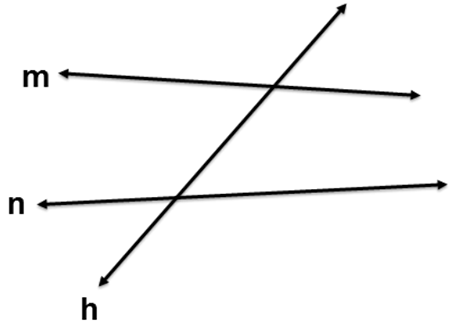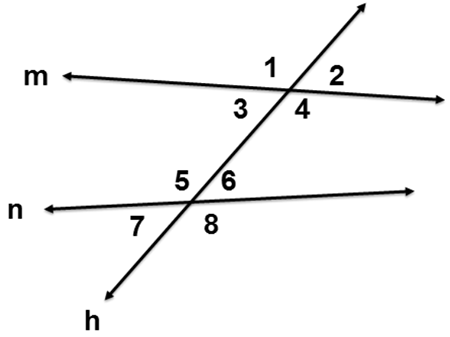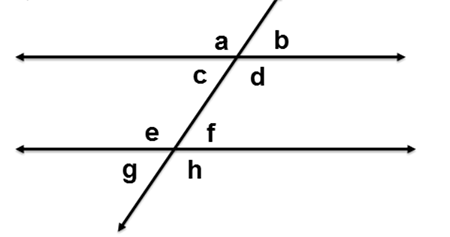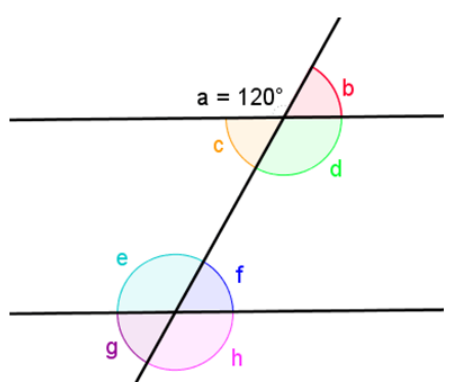Learn
Parallel Lines Cut by a Transversal
It is amazing how you can find the measures of the angles of intersecting lines given only one angle when the lines are parallel.
Vocabulary
- transversal interior angles
- exterior angles
- corresponding angles
- alternate interior
- alternate exterior
- same side interior
- same side exterior
Transversal
A transversal is a line that intersects two or more lines. Notice below how line h is the transversal because it intersects lines m and n.

Angles Formed
Also, notice the 8 angles that are formed when a transversal intersects two lines.

Parallel Lines Cut by Transversal
Something unique happens when parallel lines are intersected by a transveral. Certain pair of angles are congruent while other pairs are supplementary. Below are a pair of parallel lines cut by a transversal. Can you identify which angles are congruent and which ones are supplementary?

Exercise #1
Can you identify which angles are congruent to ∠a?

Exercise #2
Can you identify which angles are supplementary to ∠a?

Congruent Angles
Write the information below in your notes for future reference.
Below are the pairs of angles that are congruent to each other when two parallel lines are intersected by a transversal.
Alternate interior angles
Alternate exterior angles
Corresponding angles
Supplementary Angles
Write the information below in your notes for future reference.
Below are the pairs of angles that are supplementary to each other when two parallel lines are intersected by a transversal.
Same side interior angles
Same side exterior angles
Interactive Diagrams
Each link below allows you to move lines to see how this affects each pair of angles. Also, make sure you click "other pair" to the right of the diagram to see all pairs of each set.
- Math Open Reference: Alternate Interior Angles
- Math Open Reference: Alternate Exterior Angles
- Math Open Reference: Corresponding Angles
- Math Open Reference: Same Side Interior Angles
- Math Open Reference: Same Side Exterior Angles
Explore more with GeoGebra.
- GeoGebra: Alternate Interior Angles
- GeoGebra: Alternate Exterior Angles
- GeoGebra: Corresponding Angles
- GeoGebra: Same Side Interior Angles
- GeoGebra: Same Side Exterior Angles
Angle Measures
Now that you can identify each pair of angles, let's apply this information to solve problems. If we know just one angle measure then we can find the other seven angle measures when the two parallel lines are intersected by a transversal.

This is how each angle relates to angle a:
- ∠a and ∠b form a linear pair, so they sum to 180°
- ∠a and ∠c form a linear pair, so they sum to 180°
- ∠a and ∠d are vertical angles, so they are congruent. m∠d = 120°
- ∠a and ∠e are corresponding angles, so they are congruent. m∠e = 120°
- ∠d and ∠f are same side interior angles, so they are congruent, which means they are supplements. So, 120° + m∠f = 180°; m∠f = 60°
- ∠a and ∠g are same side exterior angles, so they are supplementary. So, 120° + m∠g = 180°; m∠g = 60°
- ∠a and ∠h are alternate exterior angles, so they are congruent. So, m∠h = 120°
Problem Solving
The previous example showed just one option to find an angle measure through there are other possibilities to find each angle.
Again, the theorems are only true when the lines are parallel.
Now let's incorperate this information to solve algebra problems.